Save time, money, and frustration by knowing how to spot the best wood chisels for your woodworking needs.
BobVila.com and its partners may earn a commission if you purchase a product through one of our links.
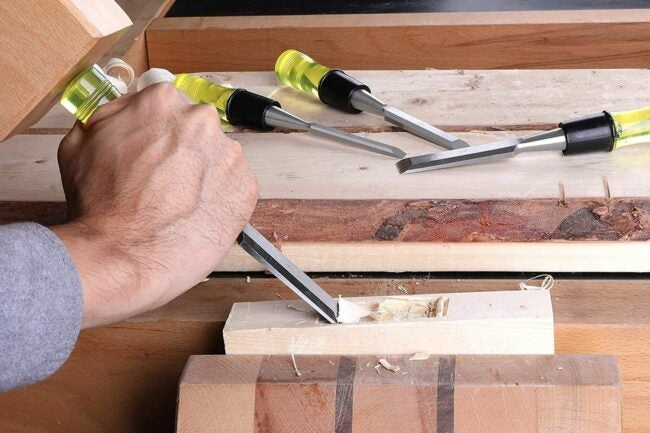
Photo: amazon.com
Chisels have been around for thousands of years, standing the test of time as one of the most versatile hand tools available. They can shave off excess wood, make intricate wood joints, and carve out custom designs. As a necessity for making fine furniture, every serious woodworker needs a quality set of wood chisels at their disposal.
As useful as they are, buying the wrong type of chisels can be a waste of time and money. To help you avoid this fate, we’re here to guide you through the process of finding the best wood chisels for your needs. Read on to discover what factors to consider and specific product recommendations vetted by us.
- BEST OVERALL: REXBETI 10pc Premium Wood Chisel Set
- BEST UPGRADE: VonHaus 10 pc Premium Chisel Set for Woodworking
- BEST BANG FOR THE BUCK: Hurricane 4 Pieces Wood Chisel Set Cr-V Construction
- BEST MORTISE: Narex Chisel / Mortise Chisel Set – 4-pcs
- BEST PARING: IRWIN Marples Chisel for Woodworking, 1/8-inch (3mm)
- BEST BENCH: WORKPRO W043001 1/2 in. Wood Chisel
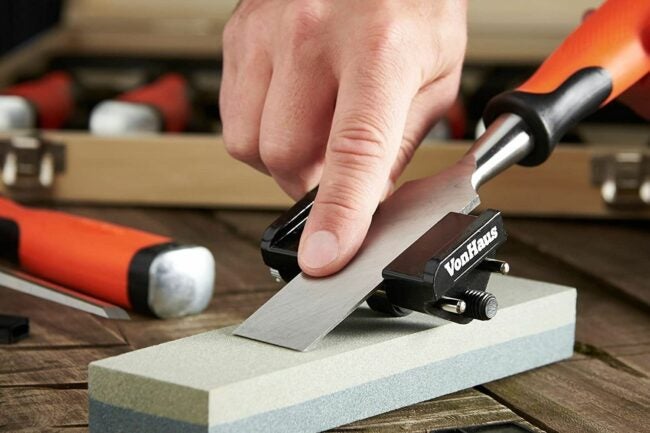
Photo: amazon.com
Types of Wood Chisels
There are many different wood chisels, but only three types are considered staples among woodworkers: the bench chisel, mortise chisel, and the paring chisel. These three will accomplish the vast majority of your tasks, so understanding what they do is an essential first step in determining what you need.
Bench Chisels
Bench chisels are the most commonly used types of wood chisels because of their multi-purpose functionality. They’re designed with versatility in mind and can do everything from cutting out wood joints in cabinets to shaving lumber in rough framing. In fact, the name “bench chisel” comes from the idea that they often permanently reside on a woodworker’s bench ready for immediate use.
A bench chisel can either have a straight or beveled-edge, with the beveled-edge bench chisel being the most common. The bevel grants a better overall balance to the chisel and more easily accommodates the sidewalls of different joints. The straight-edged variety (called the ‘firmer’ bench chisel) doesn’t share these features but is thicker and heavier for carving large sections of hard material. Both types are available in sizes from 1/16 to 3 inches, with the most useful sizes being between ¼ inch and 1 inch. A quality set of these chisels can handle almost any task you throw at them, just as long as you treat them properly and only use a wooden mallet instead of a metal hammer.
Mortise Chisels
The mortise and tenon joint is a popular joinery technique in cabinetry, and the mortise chisel is designed specifically with these in mind. While the bench chisel is theoretically capable of producing these joints, they cannot withstand the pounding and prying demands of regular mortising. On the contrary, using a bench chisel will quickly chip the blade or mushroom the handle, which is why the mortise chisel was developed in the first place.
Mortise chisels are large, thick, and heavy, making them ideal for carving out deep mortises in the toughest hardwood. They also make smaller (called ‘sash’) mortise chisels that can handle more intricate mortise work than the standard, bulky mortise chisel. Both varieties come in sizes ranging from ⅛ to ½ inch, with the most common being ¼ inch.
Paring Chisels
Where mortise chisels are useful for cutting larger joints, paring chisels produces smaller and more intricate joints in finish carpentry. They have long and thin blades made for accessing tight spaces. Because they make such meticulous cuts, you should only use the force of your hand to produce the cutting power. Doing so ensures that you won’t apply too much pressure and remove an excessive amount of material.
While they can be used as stand-alone joinery tools, paring chisels are frequently used in conjunction with a bench or mortise chisel. In this case, a mortise chisel will carve out a “rough” joint to be later refined with the fine action of the paring chisel.
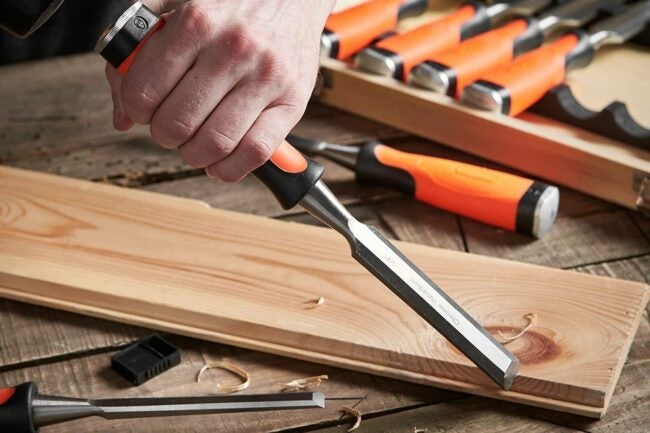
Photo: amazon.com
What to Consider When Choosing the Best Wood Chisels
Within the three primary categories of wood chisels, there are several factors to consider when choosing the right one for you. It is useful to know what you’ll be using them for, the differences between the handle and blade types, and which accessories you may need.
Purpose
First and foremost, you need to determine how you’ll primarily be using your chisel. This one step is enough to save you from wasting time and money on chisels you don’t need. For example, if you know your next project will require a lot of mortise and tenon joints, buying a set of bench chisels will likely result in broken handles and damaged blades. However, if you just need a good all-around chisel for whatever unforeseen need your project throws at you, a set of bench chisels with multiple sizes may be perfect.
Getting clear on what each type of chisel is made for is the best way to avoid getting the wrong one. Here are some basic suggestions:
- Get a bench chisel (or several) if you’re unsure exactly what you’ll need to chisel, but you know you’ll need something.
- Choose a mortise chisel if you’re planning on making multiple deep mortises (especially in hardwood).
- Select a paring chisel if you’re working on fine furniture or cabinets that require a lot of detailed shaving and joints.
Socket vs. Tang Handle
Chisels can be broadly divided into either ‘socket’ or ‘tang’ types depending on how the blade’s base (or ‘shank’) is secured to the handle. A socket chisel has a shank with a cupped indentation (or ‘socket’) that fits into a corresponding cone-shaped protrusion from the handle. Conversely, a tang chisel has a pointed shank (or ‘tang’) that fastens to the handle.
Socket chisels are usually more expensive than tang chisels because of their greater durability. Tang-types are less resilient against regular mallet beatings since they can potentially act as a wedge and split a wooden handle with enough force. For that reason, socket chisels are also more popular than tang chisels, and an excellent choice for extracting the greatest lifespan from your chisel. However, tang types can still enjoy a long life when used correctly and with care.
Handle Material
In addition to whether a handle is attached by a tang or socket, the grips themselves can either be made from wood or plastic. Wood-handled chisels are beautiful, well-balanced, and sturdy. As a result, they tend to be the preference among experienced craftsmen who are willing to pay a little extra for the look and feel of a wooden handle. The primary disadvantage is that they’re usually the most expensive and relatively less durable than plastic options.
Plastic handles feature either hard- or soft-grip plastic. Hard plastics are made from PVC, which is cheap and highly impact-resistant. They tend to be stronger than soft-grip handles composed of a rubber and hard plastic mixture, but soft-grips are generally more comfortable to use. Because of their reduced price-point and more forgiving nature, plastic handles are typically preferred by beginner woodworkers who may need a more affordable and resilient option.
Blade Material
Most chisel blades are made from either carbon or vanadium steel. Carbon steel (also called “tool steel”) has carbon added to the iron to make it harder than ordinary steel. The carbon content of most chisels is 0.6 percent to 0.75 percent, but they can also be made out of high-carbon steel with carbon content up to 1.7 percent. As a general rule, the hardness of the blade determines how long it will stay sharp for and how long it takes to resharpen.
Vanadium steel has a small amount of vanadium added to the steel to make it stronger and tougher than carbon steel. This increased hardness helps it hold a sharper edge for longer than ordinary tool steel, which is one reason why vanadium steel is also used in surgical tools that require multiple precision cuts without dulling the edge.
Western vs. Japanese Chisel
The debate over whether Western or Japanese chisels are superior has raged for decades. At the heart of this debate is two critical differences in how the chisels are made. One of the main differences is the type of steel from which the blade is made. Japanese chisels are made from much harder steel (high-carbon with low contaminates and added tungsten), while most Western chisels feature either regular tool steel or vanadium. Each type has its advantages and disadvantages. Generally, softer Western steel dulls quicker but is easier to sharpen, while the harder Japanese steel will maintain a sharp edge but takes longer to sharpen. For this reason, Japanese steel is seen as best for jobs requiring regular malleting without having to take frequent breaks to sharpen the blade.
Another key difference is the shape of the blades and handles, with Japanese chisels having shorter blades and more cylindrical (less ergonomic) handles than their western counterparts. The specific advantages and disadvantages of these different shapes and sizes are less clear. Still, the consensus is that the type you prefer is largely a matter of personal preference.
Despite the differing views, most will agree that the two styles can complement one another nicely. You are free to experiment with them both to see which one suits you best.
Size
The chisel size you choose largely depends on the type of chisel you use and its purpose. Depending on the type of chisel, they’re available in sizes as small as 1/16 inch all the way up to 3 inches. More detail-oriented work will require a smaller chisel, while larger projects (like framing) would require larger (1½- to 3-inch) chisels.
Along with the blade’s width, the length can also differ considerably. Longer blades give the greatest control and are ideal when working with flat, or otherwise easily accessible surfaces. This is why paring chisels have thin, long blades to provide greater control. Shorter, chisels are good for getting into tight places that a longer blade wouldn’t accommodate. Ideally, you should have chisels of varying lengths and widths to handle everything you expect to encounter.
Accessories
While you’re going through the time, effort, and expense of finding the perfect wood chisel for your needs, it only makes sense to consider accessories that will keep them sharp and safely stored for years to come. To this end, a sharpening device and storage method will help preserve and maintain your investment.
Since most chisels don’t come factory sharpened, you’re going to need a way to sharpen your chisels before you plan on using them. There are several options for sharpening, including:
- A sharpening stone: oil stone, water stone, or diamond stone
- Bench grinder
- Sandpaper
There’s also a number of storage options to consider, like:
- Storage cases: canvas pouch or wooden box
- Storage racks: either hand-made or purchased, wall-mounted or free-standing
- Magnetic tool holders
Finally, you’re going to need a good wooden mallet to properly use your chisels without damaging them. You can purchase one, but you can also test your chiseling skills by making your own.
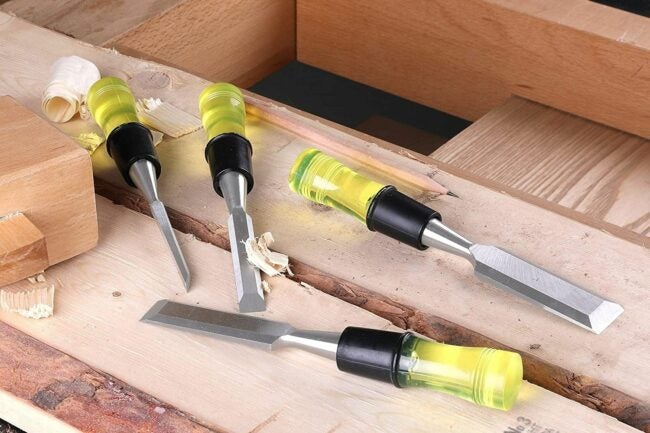
Photo: amazon.com
Tips for Buying and Using Wood Chisels
Now that you know all the factors to consider when looking for wood chisels, let’s put it all together into specific tips you can use to help you make your purchase. Our first suggestion is to buy chisels based on your experience level. Are you a beginner, an intermediate, or an advanced woodworker? If you’re a beginner, a flashy set of wooden-handled paring chisels is a recipe for broken handles and wasted money. If you’re an advanced craftsman, a plastic-handled chisel will lack the necessary balance and “feel” to do your best work, and only a wooden handle will do. Being honest about where you reside on the spectrum of experience will help you make the wisest choice for you.
Next, always keep the purpose of your chisel in mind. Remember, use bench chisels for general-purpose shaving and joining, mortise chisels for deep mortises, and paring chisels for fine details. Selecting your chisels based on its intended use is the single best way to avoid wasting precious time and money.
Here are a few more tips:
- Start with a general-purpose set of bevel-edged bench chisels of varying sizes (especially ¼ inch, ½ inch, ¾ inch, and 1 inch).
- Consider more specialized chisels (like the mortise and paring) if you need to make lots of specific joints your bench chisels won’t produce.
- Start with the more affordable Western-style chisels, and consider experimenting with Japanese chisels once you’ve gained more experience.
- Choose a handle material based on your woodworking experience level: plastic if you’re a beginner, and wood if you’re intermediate or advanced.
- Select a blade material based on how often you’re willing to sharpen it, and how hard the wood is.
Our Top Picks
With so many factors and options to consider, it’s easy to be left in a state of analysis paralysis when shopping for the best wood chisels. That’s why we’ve included our top picks in several key categories to help take the guesswork out of your decision. We’ve incorporated our key considerations in making these selections, and found those with the most outstanding value for the money.
Best Overall
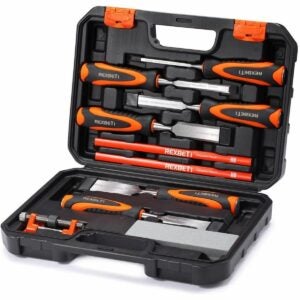
The REXBETI 10-piece set comes with everything you need to start chiseling. It contains six chisels from ¼ inch to 1½ inch, a sharpening stone, a honing guide, two carpenter pencils, and a carrying case. The vanadium steel blades are factory sharpened and ready to use, which is a unique feature not shared by most of its competitors. When you are prepared to sharpen them, the included sharpening stone and honing guide can quickly get you back in business.
The handles are made out of hardened plastic and have metal striking caps that make them even more resilient against regular malleting. Even the carrying case is sturdy enough to bring along with you to the job site. While this set is geared towards beginners, its unique features and affordable price-point make it an ideal overall kit.
Best Upgrade
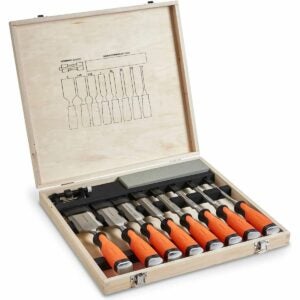
VonHaus’ 10-piece set is a great foundational collection for woodworkers of all experience levels. It includes an expanded range of chisel sizes, from ¼ inch all the way up to 2 inches, all housed in a beautiful wood carrying case that is as sturdy as it is attractive. The ergonomically shaped rubberized plastic handles bring comfort and control to prolonged malleting operations, and the metal striking caps keep the handles protected. The hardness of the handles is complemented by the heat-treated vanadium steel made to stand up against the most rigid material. When they’re ready to be sharpened, the 120 and 200 grit aluminum oxide sharpening stone will quickly put an edge back on the blades.
If you think the 10-piece set is more than you need, VonHaus offers a six-piece and eight-piece version for optimal flexibility. Unfortunately, these smaller kits don’t include the metal striking caps and wooden carrying case, making us choose the 10-piece version as our upgrade pick. Whichever kit you choose, these premium chisels make a great starter or upgrade set.
Best Bang for the Buck
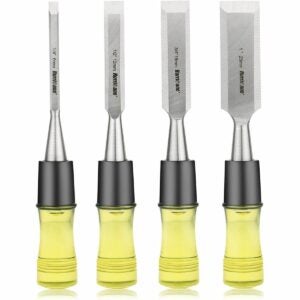
If you’re a craftsman on a budget but still need a quality set of chisels, this four-piece set from Hurricane has all the essential sizes you need. The ¼, ½, ¾, and 1-inch vanadium steel blades are sharp and durable and come pretreated with a lacquer surface coating to lubricate and protect the blades. The handle is made from impact-resistant hardened plastic that won’t split from your mallet’s force.
Although it doesn’t include a storage option (like a carrying case), it does have four plastic protection caps to protect the blades when they’re not in use. This set also lacks a sharpening device, so you’ll need to get one separately if you don’t already have one. Despite those limitations, there are few other options with so many positive features at such a reasonable price.
Best Mortise
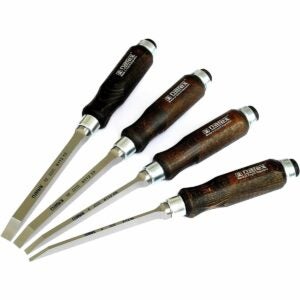
For chisels that will hold their own in the face of regular mortise work, these four mortise chisels from Narex are just the tools for the job. The 4 mm, 6 mm, 10 mm, and 12 mm blades are made of thick chrome-manganese steel with just the right length, taper, and 25-degree bevel to make perfect mortises. The handles are made from a beautiful stained beechwood with two steel ferrules that provide additional reinforcement against repeated prying and malleting.
The price might be a little out of reach for the beginning woodworker, but intermediate and advanced artisans will appreciate the balance, beauty, and function of these well-made chisels.
Best Paring
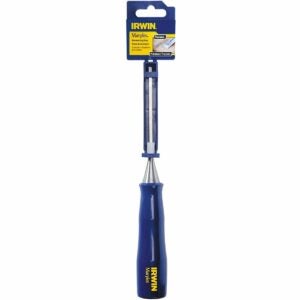
The long, slim blade of Irwin’s ⅛-inch chisel is crafted with the precision shaving capabilities required of paring chisels. The long carbon-steel blade provides the ideal leverage for scrupulously chiseling with the force of your hand alone. It’s affordable enough to allow beginners a paring chisel to expand their skill set, and the quality is sufficient for more advanced woodworkers to appreciate.
The hardened PVC plastic handle is made with the beginner in mind, and more advanced woodworkers may not appreciate the top-heavy nature of the plastic.
Best Bench
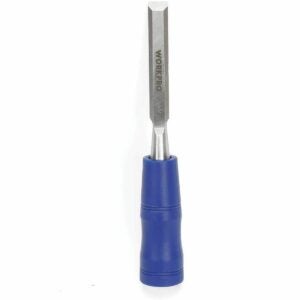
WORKPRO’s ½-inch bench chisel marries affordability with functionality into a single high-quality chisel at an incredibly affordable price. Whether you need a single chisel for general use or to complete an existing set, this ½-inch chisel is hard to beat. The blade is made of hardened tool steel that is protected from dings in storage with a provided plastic end cap. It sharpens quickly and stays sharp even against hard and laminated woods. Its hard plastic handle with a metal strike cap is made with durability in mind.
The WORKPRO line of single bench chisels also offers a ¾-inch and 1½-inch option, making it possible to add to your collection as the need arises. They do need to be sharpened before use, so make sure you have a means of sharpening them before ordering.
FAQs About Wood Chisels
Naturally, a tool as versatile as a wood chisel will come with its fair share of questions. Here are the answers to some of the common questions.
Q. How do you chisel wood for a door hinge?
After marking out where the hinge will go, use an adequately sharp 1¼-inch mortise or bench chisel to make several shallow cuts the same depth of the hinge. Follow up with horizontal slices to remove the notched out area.
Q. How do you sharpen a wood chisel?
You can use a sharpening stone, sandpaper, or a bench grinder to sharpen your wood chisel.
Q. What size of chisels should I buy?
It depends on what you’re going to use it for, but a ¼-inch, a ½-inch, a ¾-inch, and a 1-inch bench chisel can handle most jobs.
Q. How do you store wooden chisels?
You can store your chisels in a pouch, a case, a storage rack, or a magnetic tool holder.
tinyurlis.gdv.gdv.htclck.ruulvis.netshrtco.de
مقالات مشابه
- بهترین سایتهای خرید بیسیم واکی تاکی [بررسی و مقایسه]
- 27 را جلوتر دستور العمل های دسر در حال حاضر از طریق روز کارگر
- نوآورانه ترین گونه های جدید خود را برای سال 2020 باغ سبزی
- شرکت صادرات و واردات کالاهای مختلف از جمله کاشی و سرامیک و ارائه دهنده خدمات ترانزیت و بارگیری دریایی و ریلی و ترخیص کالا برای کشورهای مختلف از جمله روسیه و کشورهای حوزه cis و سایر نقاط جهان - بازرگانی علی قانعی
- 16 آمریکایی Downtowns که در حال ساخت باز گشت
- خرید کتاب صوتی
- لهستان برخورد با موج خبر جعلی قبل از شروع از عمده تمرین نظامی با ما
- فروش کربن فعال مشتق از زغال سنگ
- شرکت صادرات و واردات کالاهای مختلف از جمله کاشی و سرامیک و ارائه دهنده خدمات ترانزیت و بارگیری دریایی و ریلی و ترخیص کالا برای کشورهای مختلف از جمله روسیه و کشورهای حوزه cis و سایر نقاط جهان - بازرگانی علی قانعی
- 7 نوع از فوستس آشپزخانه بدانید